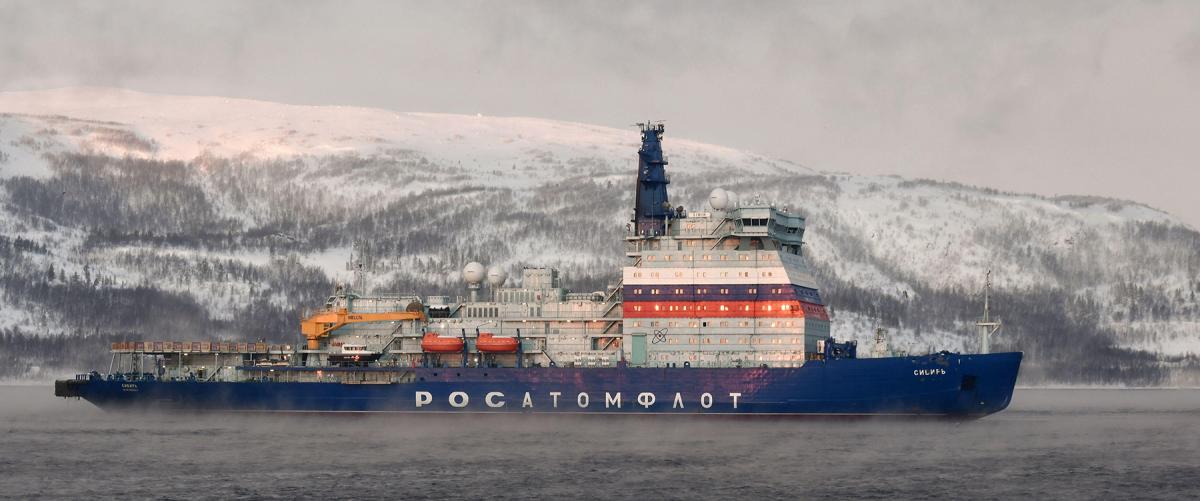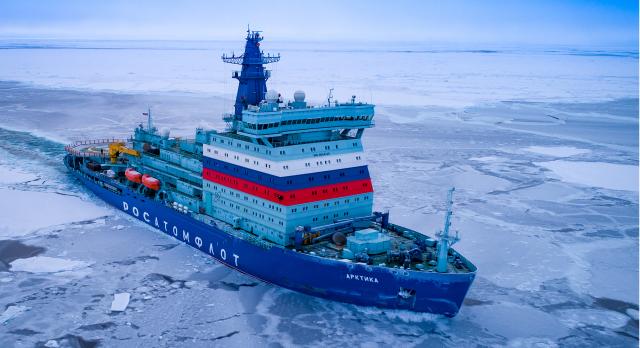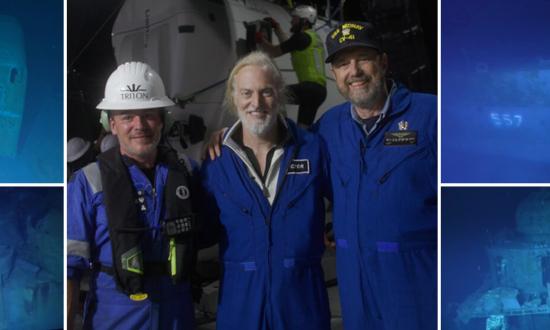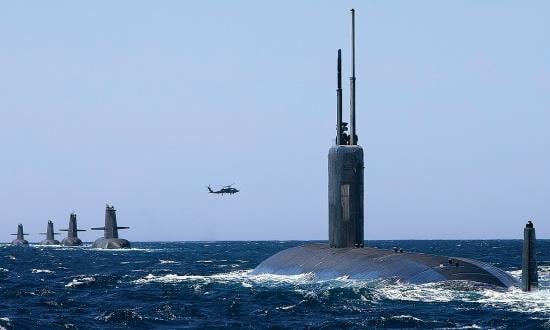The nuclear-powered icebreakers Arktika and Sibir—the first two in a class of five—are fully operational and were accepted into Russia’s Rosatomflot fleet in late 2021 and early 2022. Both are escorting commercial cargo vessels in winter sea ice along the Northern Sea Route (NSR)—Russia’s National Arctic Waterway.
These new icebreakers, the world’s largest and most powerful, each have two RITM-200 light-water reactors that produce pressurized water and steam for a turboelectric generating plant. The steam turbines drive two turbogenerators that produce electricity for three electric motors; the motors drive three shafts and four-bladed propellers. The system produces 80,000 maximum shaft horsepower, the most power on board any icebreaker, and the Arktika can break 9 feet of level sea ice at a continuous 1.5 to 2 knot speed, as reported by her designers. Few sea ice features will slow or stop this ship from continuous forward motion with such high available power and a large displacement of 33,530 deadweight tons. Also notable are the 569-foot length and 112-foot beam, which creates a wide track astern for ships under ice escort.
Three follow-on ships—all being built by the Baltic Shipyard in St. Petersburg and in various stages of construction—also have geographic names: Ural, Yakutia, and Chukotka. Rosatomflot, manager of the nuclear icebreaker fleet and a division of Rosatom, the State Atomic Energy Corporation, has indicated a need for two more ships in the class to maintain year-round navigation along the NSR. These new ships will replace two classes of nuclear icebreakers: the shallow-draft Taymyr and Vaygach (operational since 1989 and 1990) and older ships of the original Arktika class. A key objective is that Rosatomflot one day will operate a fleet of identical ships providing enhanced efficiency and cost savings. For example, engineering parts and the ship’s officers and crews can be more easily interchanged within the fleet.
One of the critical features of the new Arktika-class icebreakers is their dual-draft design, which allows winter operations in the shallow, estuarine waters of the Ob and Yenisey Rivers in western Siberia. These waters provide bulk carriers, tankers, and liquefied natural gas carriers access to ports servicing natural resource development projects. By deballasting water, the Arktika class can reduce its normal displacement by 8,000 tons to 25,540 deadweight tons; the normal, deep-water draft of 34 feet is reduced to a lower draft of 29 feet. There is some concern, however, that the minimum deadweight tonnage after ballast water discharge remains too heavy for the ships to operate effectively in the fresh and brackish waters of the Siberian rivers. Future winter operations will provide more evidence of any operational limitations in shallow, coastal waters.
The hull design and propulsion system appear conservative and consistent with earlier Russian and Soviet nuclear icebreakers. Traditional shafts and a single rudder are provided; no pods or steerable (electric) propulsion units are used; and propeller blades are bolt-on, not controllable pitch. The reported crew size is 75, down from more than 100 on board earlier Russian nuclear icebreakers. This reduction likely means greater systems automation, as well as indicating more routine maintenance will be conducted ashore at the base in Murmansk.
These state-owned vessels are designed primarily for commercial ship escort and ice operations to extend the navigation season along the NSR. However, they are highly valuable, multimission assets, and using the unlimited endurance of nuclear ship propulsion, can provide year-round access to the entire length of the ice-covered Russian maritime Arctic. They can fully support national security interests by escorting naval vessels along the NSR and assisting the resupply of bases on the Russian Arctic islands. They also can conduct scientific expeditions, but it is doubtful they will take tourists on voyages to the North Pole as previous Russian icebreakers have done since 1991. The new Arktika-class icebreakers are extraordinary ships that provide the Russian Federation with a unique, surface ship capability anywhere in the Arctic Ocean.







